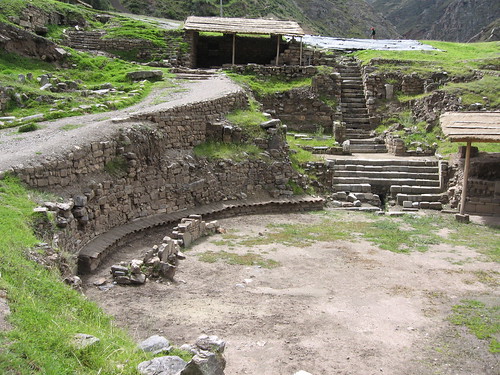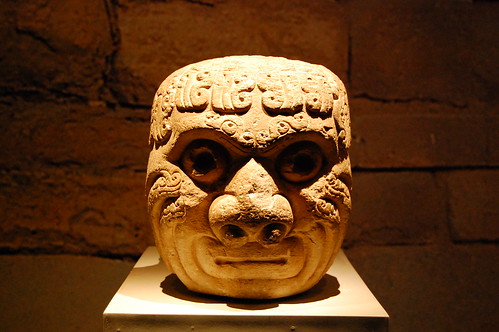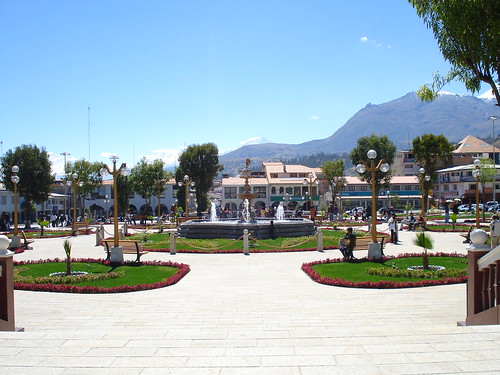
More than 2000 years before the conquest of the Incas, the people of the plateau created a sacred center of Chavín Huantar. The ruins were already legendary when the Spanish explorers arrived in the region. Julio C. Tello was one of the founders of the Peruvian and the first archaeological dig at Chavín to 1919.
Chavin de Huantar is an archaeological site located in the district counterpart, the province of Huari, Ancash department. It is 462 kilometers northeast of Lima, Peru. His monumental religious architecture and sculpture was built approximately 900 years between 200 BC Among the sections that have been documented include: a large mound in the form of a truncated platform, cross-platform low side, a small patio and a large circular sunken plaza rectangular semi-subterranean.
Chavín artists, instead of representing the flora and fauna of the region, carved unforgettable images of alligators, jaguars and eagles with crest, often combined in hybrids formidable; dominant animal of water, land and air in the tropical lowlands and its environment is very main to the east in the jungles of the Amazon. The Tello Obelisk, a prism-shaped sculpture and carved in granite, worked as a center of worship rather than as architectural ornament. The Obelisk is one of the few sculptures that represent both plants and animals.

The monolithic Lanzón, emblematic of five meters high, is an anthropomorphic figure that appears to represent a dwarf form with a grotesque head three times larger than its body, and shows enormous jaguar fangs of Otorongo or puma, with Foot-shaped claws and scepters in their hands.

Raimondi Stela is one of the masterpieces of Chavín. Slab, engraved on one side, it measures 198 cm high, 74 wide and 17 thick. The figure represented is that of an anthropomorphic being, standing, seen from the front, with open arms, holding a rod in each hand. It has the commissures of the mouth turn down, and upper and lower teeth. Two thirds of the stone made a deal with a complication of hair. The figure is identified with a deity called «rods from God» figure that is repeated in several Andean cultures, and was supposed to be adored in the New Temple.
Like architecture, sculpture religious characteristics unique to one region. The carved images that adorned the walls of the platforms and walls of the courtyards were also outside the natural environment of the place. And much of the stone used for the sculptures and the outside of the pyramid was white granite and black limestone deposits transported from distant to the region.
In the underground chambers adjacent to the circular courtyard, called Galleries offerings have been found hundreds of pottery decorated to serve food and beverages, catering and exotic fish and mussels from the coast, as well as llamas and guinea pigs or guinea pigs. They suggest holding ceremonial banquet in those areas of the temple. We also found fragments of burned human bones that have led to postulate the possibility of ritual cannibalism.
The designers managed to create a temple of the union between architecture and the weather system that religious leaders sought to control through their rituals. Lumbreras suggests that during the rainy season, the sound of water channels could be heard throughout the temple, created due to the echo in the underground chambers. Thus, the system of channels created a physical and symbolic union between church and mountainous terrain that surrounded.
The temple of Chavin de Huantar presented himself as a cosmic center in which opposing forces are reconciled and where the balance is maintained through religious ceremonies. Since its inception, was a place where different units joined local social peacefully. The ascendancy of Chavín as a cosmic center, along with its more mundane functions, led him to build one of the most important centers of trade and cultural contact between distant regions. Therefore, they must acknowledge their roles in the dynamics of cultural art, architecture and rituals in the evolution of the Andean civilization.
Museo Regional Anchash
It is a small museum in which we should pass before going to Chavín de Huantar. It also has several sculptures Chavín. We also found parts culture Recuay. The pictures above are a bit old, but the whole is notable for the beautiful garden of statues. The ideal months to tour the area from June to August.
Practical information
Location: Plaza de Armas.
Hours:
• From Monday to Saturday from 9:00 a.m. to 6:30 pm.
• Sundays from 9:00 a.m. to 2:00 pm
Price: 1.45 USD
How to get there?
To reach this wonder we start getting our first trip to Huaraz, capital of the Ancash region, located 400 km from Lima and 200 km. the coast, which is reached by an asphalt road. You can take one of many interprovincial bus services or hiring a specific holiday to visit the area. There are also flights from Lima.

Good luck!
Leave a Reply
You must be logged in to post a comment.
Recent Comments